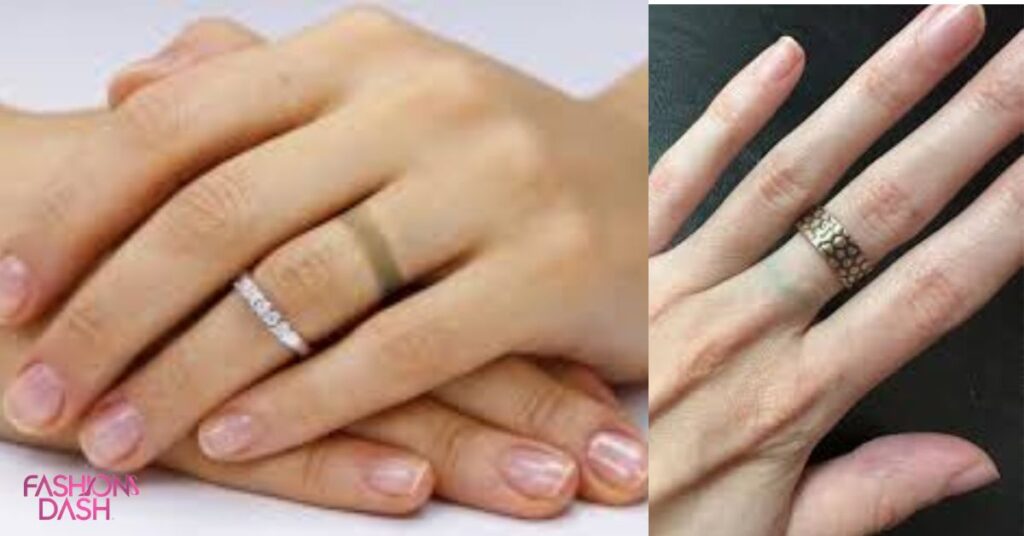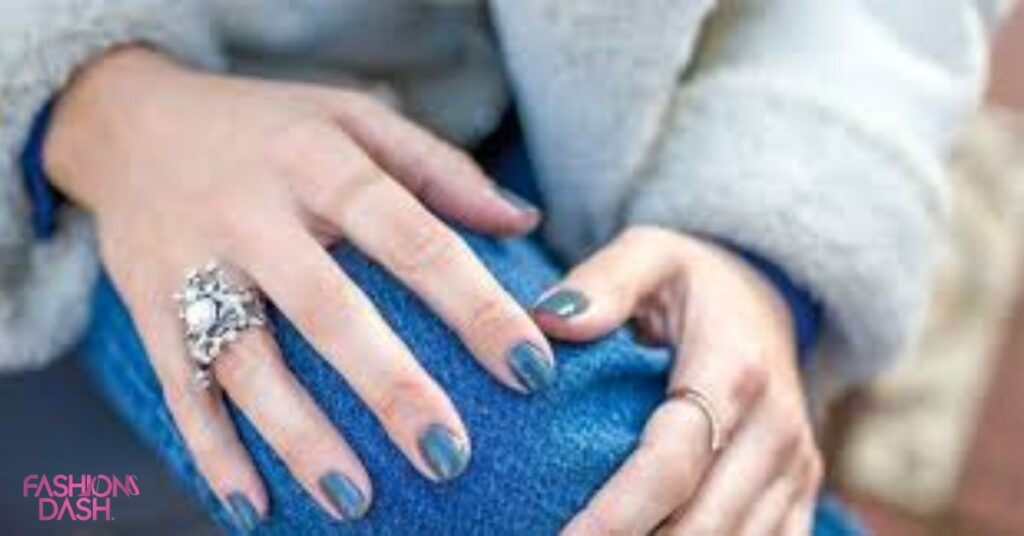Jewelry is a beloved accessory that adds sparkle and style to our outfits. However, for some, wearing certain pieces of jewelry can lead to an unexpected side effect: green skin.
Have you ever slipped on a beautiful piece of jewelry, only to discover later that it left an unwanted green mark on your skin? Yes, the green mark left by jewelry is a common issue caused by a chemical reaction between the metal and your skin.
we’ll explore the science behind why certain jewelry turns your skin green, the types of metals responsible, and practical tips to keep your skin looking vibrant and healthy. Join us as we delve into the fascinating world of jewelry and skin chemistry.
Why Does Your Skin Turn Green?
The green color occurs when the metals in your jewelry react with the oils on your skin, causing oxidation. This is similar to how rust forms on metal. Jewelry is typically made by mixing different metals to create an alloy that balances color, integrity, solidity, and purity. When cheaper metals or copper are used, they can react with the skin’s oils and sweat, leading to green discoloration.
What Causes Your Skin to Turn Green?
When certain metals, such as copper or alloys containing copper, come into contact with your skin, they can undergo a chemical reaction. This reaction is primarily triggered by the acidity of your skin, which varies from person to person. Sweat, lotions, and other substances on your skin can also contribute to this.
It’s simply a surface reaction and does not mean that the jewelry is of low quality. if you have sensitive skin or allergies, it’s a good idea to avoid jewelry that contains metals known to cause reactions.
How to Prevent Skin Discoloration
Preventing skin discoloration from jewelry involves several key strategies. Firstly, choosing jewelry made from metals less likely to cause reactions, such as solid gold or stainless steel, can reduce the risk. Additionally, coating the jewelry with clear nail polish creates a barrier between the metal and your skin, preventing direct contact.
It’s also important to keep jewelry dry, as moisture can accelerate the reaction. Regular cleaning with mild soap and water helps remove sweat, oils, and lotions that can contribute to skin discoloration. Proper storage in a dry environment can also prevent moisture buildup and oxidation of the metal. For those with sensitive skin or allergies, opting for hypoallergenic jewelry can be beneficial. These measures can help you enjoy your jewelry without the worry of skin discoloration.
what common skin discoloration color comes from jewelry other than green?

In addition to green, jewelry can cause skin discoloration in several other colors:
Black: Skin can turn black when jewelry containing metals like silver oxidizes. Silver reacts with substances on the skin, such as sweat and oils, to form silver sulfide, which has a black color.
Blue: Some jewelry, especially that containing metals like cobalt or chromium, can react with the acids in your skin to produce a blue discoloration. This reaction is more common in people with acidic skin.
Red or Pink: Certain metals, such as nickel or copper, can cause a red or pink rash or discoloration on the skin. This reaction is often due to an allergic reaction to the metal.
Yellow: Jewelry made with gold alloys can sometimes leave a yellowish tint on the skin. This is more common with lower-karat gold, which contains a higher percentage of other metals like zinc or silver.
These discolorations are usually harmless and temporary, and they can often be washed off with soap and water it’s best to avoid wearing jewelry that causes these effects.
Metals That Cause Skin Discoloration
Here are a few types of metals that cause the skin green;
Copper: Copper is one of the most common metals found in jewelry alloys. While it’s a beautiful and affordable metal, it’s also prone to oxidizing, especially when exposed to moisture. Jewelry made with copper or copper alloys is more likely to cause green skin.
Nickel: Another metal notorious for causing skin reactions is nickel. Nickel is often used as a base metal in jewelry, especially in costume and fashion jewelry. It can trigger allergic reactions in some people, leading to redness, itching, and skin discoloration.
Other Metals: Zinc, tin, and brass are other metals commonly found in jewelry that can cause skin discoloration. These metals, like copper, are prone to oxidation and can leave green marks on the skin.
How to Keep Your Skin Green-Free Ideas
Here are a few tips for keeping your skin green free;
Choose High-Quality Jewelry: opt for jewelry made from high-quality metals like solid gold, sterling silver, or platinum. These metals are less likely to oxidize and cause skin discoloration.
Avoid Cheap Alloys: Be cautious when purchasing jewelry made from unknown alloys or cheap metals. These are more likely to react with your skin and cause discoloration.
Apply a Protective Coating: To create a barrier between your skin and the metal, consider applying clear nail polish to the inside of the jewelry. This can help prevent the metal from coming into direct contact with your skin.
Keep Your Jewelry Dry: Remove your jewelry before swimming or bathing, as exposure to water can accelerate the oxidation process. Additionally, avoid wearing jewelry during activities that cause you to sweat excessively.
Clean Your Jewelry Regularly: Regular cleaning can help remove dirt, oils, and other substances that can contribute to oxidation. Use a mild soap and water solution to clean your jewelry, and ensure it’s completely dry before wearing it again.
Consider Allergy-Tested Jewelry: If you have sensitive skin or a known allergy to certain metals, look for jewelry that is hypoallergenic or allergy-tested.
ALSO READ THIS BLOG ; WHAT COLOR SHOES TO WEAR WITH THE BLUE DRESS
Does the Green Color Wash Off?

Yes, the green color left on your skin from jewelry can typically be washed off. The green color is caused by a reaction between the metal in the jewelry and the acids in your skin, which form compounds like copper oxide. These compounds are not deeply absorbed into your skin but rather sit on the surface, which is why they can be washed away with soap and water.
To prevent this from happening, you can try coating the inside of the jewelry with a clear nail polish to create a barrier between your skin and the metal. This can help reduce the likelihood of the reaction occurring and the green color appearing on your skin.
Frequently Asked Question
Why does jewelry turn skin green?
Jewelry can turn skin green due to a chemical reaction between the metal in the jewelry and the acids in your skin. This reaction, known as oxidation, creates a green residue on the skin.
Which metals are most likely to cause skin discoloration?
Copper is a common culprit for causing skin discoloration. Other metals like nickel, zinc, and brass can also react with skin acids and cause a green hue.
Can the green color be washed off?
Yes, the green color is not permanent and can be easily washed off with soap and water. However, it may reappear each time you wear the jewelry.
How can I prevent jewelry from turning my skin green?
To prevent jewelry from turning your skin green, you can coat the metal with clear nail polish to create a barrier between your skin and the metal. Additionally, choosing high-quality jewelry made from metals less likely to oxidize, such as solid gold or sterling silver, can help prevent skin discoloration.
Is it possible to have an allergic reaction to jewelry that turns skin green?
Yes, some people may have an allergic reaction to certain metals in jewelry, such as nickel. This reaction can manifest as redness, itching, or skin discoloration. If you suspect an allergic reaction, it’s best to avoid wearing jewelry made from that metal.
Conclusion
While green skin from jewelry may be a common occurrence, it’s a temporary and harmless effect. By understanding the science behind discoloration and taking preventive measures, you can continue to enjoy wearing your favorite pieces without worrying about unwanted side effects. Choose high-quality metals, keep your jewelry clean and dry, and consider protective coatings to keep your skin looking green-free and radiant.

Clara , a fashion blogger with four years of experience, specializes in creating captivating content on fashion trends, styling tips, and beauty hacks, establishing herself as a trusted resource for fashion enthusiasts.







